Key Performance Indicators for the Upgrade of Existing Coastal Defense Structures
Abstract
:1. Introduction
2. The Database
2.1. Tested Configurations
- Extension of the wall height hw from 0.04 m to 0.05 m; this upgrade is denoted as “hw” in the following charts and tables;
- Extension of the berm width B from 0.15 to 0.30 m (denoted as “B”);
- Inclusion of a sloping parapet on top of the crown wall (upgrade “ε”); the parapet was characterized by an inclination angle of ε = 30° and a relative height λ = hn/hw = 0.375, where hn is the parapet height (see Figure 1);
- Extension of hw and contemporary inclusion of the parapet (upgrade “hw + ε”);
- Simultaneous extension of hw and B (upgrade “hw + B”);
- Widening of B and simultaneous inclusion of the parapet (upgrade “B + ε”);
- Simultaneous extension of hw, widening of B, and inclusion of the parapet (upgrade “hw+B+ε”).
2.2. Laboratory Measurements
2.3. Characterization of the New Data
- (i)
- Slightly breaking waves;
- (ii)
- Impact loads;
- (iii)
- Broken waves;
- (iv)
- Quasi-standing waves.
- The first design formula for predicting the wave forces on a smooth dike crown wall under irregular, non-breaking waves by Van Doorslaer et al. [31]. This formula was developed based on two sets of experiments on dikes with sloping promenades and crown walls, without parapets, carried out at different scales in the wave flume at Ghent University (“UGent data” in Figure 7 and Figure 8) and in the CIEM (Canal d’Investigació i Experimentació Marítima) wave flume of the Universitat Polytecnica de Barcelona in the context of the Hydralab project (“Hydralab data” in Figure 7 and Figure 8). The two sets of experiments were carried out at different scales, so the formula consists of two different fittings, accordingly;
- The latest formula by De Finis et al. [35], developed on the basis of numerical simulations carried out with the IH2VOF code (developed by the University of Cantabria) to explicitly extend the Hydralab dataset with various promenade lengths and wall heights and breaking waves (“IH2VOF” in Figure 8). This formula refits the previous [31], including the parameters ξm-1,0, B and hw.
3. Integrated Analysis
3.1. Effectiveness of the Structural Upgrades
3.1.1. Hydraulic Performance
3.1.2. Structural Performance
3.2. Integrated Discussion
3.3. Costs and Environmental Impact
4. Key Performance Indicators
- The “hydraulic effectiveness” (I) and the “structural effectiveness” (II) of a configuration of structural upgrades as defined in Section 3.1. with reference to the corresponding basic configuration, and through the definition of the Red factors of Equation (1);
- The “costs” (III) and the “environmental impact” (IV) of a configuration of structural upgrades with reference to the corresponding basic configuration and based on the Δcost and the Δenv values presented in Section 3.3 and summarized in Table 2.
4.1. Scores Assignment
- Internal consistency and logical soundness;
- Ease of use;
- Ability to provide an audit trail.
- All of the criteria I, II, III, and IV were weighed equally to avoid any subjectivity. The setup of weighing coefficients to reflect the relative importance of each criterion would indeed require a complicated analysis of the costs/benefits, allowing for the opinions and interests of the various stakeholders to be collected through surveys and interviews, which was beyond the scope of the present contribution;
- The scores of each criterion were calculated through simple, linear transformations of the quantities Red (criteria I and II), Δcost (III), and Δenv (IV);
- Finally, all of the Scores and the KPIs were rounded to the closest integer numbers.
4.2. Definition of the KPIs
- KPIeff < 0 are globally ineffective and counterproductive, because the increases associated with F* and/or q* are overall greater than the reductions. These configurations are therefore strongly not recommended;
- KPIeff = 0 are globally ineffective; this case may be due to two different causes: (1) the reduction in q* (or F*) is counterbalanced by an increase in F* (or q*); (2) the reductions in both q* and F* are 0. In both cases, these configurations are not recommended because they are useless in terms of reducing q* and F*;
- KPIeff > 0 are globally effective and, therefore, recommendable depending on the end-user’s judgement of the corresponding KPI values.
5. Application of the KPIs
5.1. Application to the Unibo Dataset
5.1.1. Ranking of the Upgrades
5.1.2. Optimizing the Performance of the Upgrades
5.1.3. Variability of the Results
5.2. Application to Literature Datasets
- Pearson et al. [11], who collected 373 experimental data on wave overtopping and wave forces on crown walls on top of differently armored rubble mound breakwaters (rock, cube, and dolos);
- Smolka et al. [19], who carried out small-scale 2D tests against a cube- and Cubipod-armored mound breakwater, measuring the data of the dimensionless horizontal and uplift forces, and of the overturning moments at the crown wall;
- Martinelli et al. [17], who conducted regular and irregular tests of wave overtopping against a seawall with a recurved parapet whose inclination angle ε was varied between 0° and 90°. During the tests, measurements of the overtopping discharge and of the wave forces at the base of the wall were collected.
6. Conclusions
- The combination of upgrades presenting, on average, the highest performance throughout the whole dataset is the one including hw + ε (i.e., the contemporary extension of the crown wall and of the berm width).;
- The upgrades hw, ε and hw + ε—consistently scoring KPI > 0—are recommendable for all of the structural configurations under standard and increased wave heights and sea levels;
- The upgrades B and hw + B score negative KPI values due to their high economic costs and significant environmental impact associated with the berm extension. Nevertheless, these upgrades are effective in reducing q and F for all of the structural configurations, wave conditions, and sea levels;
- The combination of berm extension and introduction of parapet (upgrades B + ε and hw + B + ε) is not recommended (KPI < 0), as it is expensive, environmentally detrimental and, on average, ineffective in reducing q and F;
- The hydraulic and structural effectiveness of any structural upgrade (B, hw and ε) is overall optimized in the event of slightly breaking conditions (Fmax/Fhq < 2.5), representing an intermediate situation, between the broken waves (Fmax/Fhq ≈ 1) and the impact loads (Fmax/Fhq > 2.5);
- The performance of the structural upgrades is better for the configurations with the slope c4 corresponding to non-breaking waves, as well as in the case of a submerged berm, i.e., in the sea level rise scenario.
Funding
Institutional Review Board Statement
Informed Consent Statement
Data Availability Statement
Acknowledgments
Conflicts of Interest
Appendix A
Group of Structures with Basic Configuration c2hb0  | ||||||||||
|---|---|---|---|---|---|---|---|---|---|---|
| Upgrade | Red(q*) (-) | Red(F*) (-) | Δcost (EUR/m2) | Δenv (-) | Score (q*) (-) | Score (F*) (-) | Score (Δcost) (-) | Score (Δenv) (-) | KPIeff (q*, F*) (-) | KPI (q*,F*, Δcost, Δenv) (-) |
| hw | −0.46 | −0.15 | 32.00 | 0.25 | 4 | 2 | −1 | 6 | 5 | |
| B | −0.17 | −0.35 | 8400 | 0.25 | 2 | 3 | −10 | −4 | 5 | −9 |
| ε | −0.14 | −0.25 | 36.00 | 0.87 | 1 | 3 | 0 | 0 | 4 | 4 |
| hw + ε | −0.57 | −0.12 | 77.00 | 0.00 | 6 | 1 | 0 | −1 | 7 | 6 |
| hw + B | −0.60 | −0.44 | 8432 | 0.26 | 6 | 4 | −10 | −6 | 10 | −6 |
| B + ε | −0.22 | 0.17 | 8436 | 1.12 | 2 | −2 | −10 | −4 | 0 | −14 |
| hw + B + ε | −0.71 | 0.21 | 8477 | 0.87 | 7 | −2 | −10 | −6 | 5 | −11 |
| Min | −0.71 | −0.44 | 0.00 | 0.00 | 1 | −2 | −10 | −6 | 0 | −14 |
| Max | 0.00 | 0.21 | 8477 | 1.13 | 7 | 4 | 0 | 0 | 10 | 6 |
| μ | −0.36 | −0.12 | 4239 | 0.56 | 4.00 | 1.29 | −5.77 | −3.17 | 5.29 | −3.65 |
Group of Structures with Basic Configuration c2hb05  | ||||||||||
| Upgrade | Red(q*) (-) | Red(F*) (-) | Δcost (EUR/m2) | Δenv (-) | Score (q*) (-) | Score (F*) (-) | Score (Δcost) (-) | Score (Δenv) (-) | KPIeff (q*, F*) (-) | KPI (q*,F*, Δcost, Δenv) (-) |
| hw | −0.39 | −0.01 | 32.00 | 0.25 | 4 | 0 | 0 | −1 | 4 | 3 |
| B | −0.09 | −0.25 | 8400 | 0.15 | 1 | 2 | −10 | −9 | 3 | −16 |
| ε | −0.24 | −0.18 | 36.00 | 1.87 | 2 | 2 | 0 | 0 | 4 | 4 |
| hw + ε | −0.62 | −0.06 | 77.00 | 0.00 | 6 | 1 | 0 | −1 | 7 | 6 |
| hw + B | −0.57 | −0.22 | 8432 | 0.15 | 6 | 2 | −10 | −10 | 8 | −12 |
| B + ε | −0.31 | 0.36 | 8436 | 2.01 | 3 | −4 | −10 | −9 | −1 | −20 |
| hw + B + ε | −0.09 | 1.65 | 8477 | 1.87 | 1 | −17 | −10 | −10 | −16 | −36 |
| Min | −0.62 | −0.25 | 0.00 | 0.00 | 1 | −17 | −10 | −10 | −16 | −36 |
| Max | 0.00 | 1.65 | 8477 | 2.01 | 6 | 2 | 0 | 0 | 8 | 6 |
| μ | −0.29 | 0.16 | 4239 | 0.90 | 3.29 | −2.00 | −5.77 | −5.69 | 1.29 | −10.17 |
Group of Structures with Basic Configuration c4hb0  | ||||||||||
| Upgrade | Red(q*) (-) | Red(F*) (-) | Δcost (EUR/m2) | Δenv (-) | Score (q*) (-) | Score (F*) (-) | Score (Δcost) (-) | Score (Δenv) (-) | KPIeff (q*, F*) (-) | KPI (q*,F*, Δcost, Δenv) (-) |
| hw | −0.52 | −0.22 | 32.00 | 0.25 | 5 | 2 | 0 | −1 | 7 | 6 |
| B | −0.28 | −0.29 | 8400 | 0.25 | 3 | 3 | −10 | −4 | 6 | −8 |
| ε | −0.06 | −0.12 | 36.00 | 0.87 | 1 | 1 | 0 | 0 | 2 | 2 |
| hw + ε | −0.59 | 0.40 | 77.00 | 0.00 | 6 | −4 | 0 | −1 | 2 | 1 |
| hw + B | −0.72 | −0.52 | 8432 | 0.26 | 7 | 5 | −10 | −6 | 12 | −4 |
| B + ε | −0.46 | −0.36 | 8436 | 1.12 | 5 | 4 | −10 | −4 | 9 | −5 |
| hw + B + ε | −0.79 | −0.58 | 8477 | 0.87 | 8 | 6 | −10 | −6 | 14 | −2 |
| Min | −0.79 | −0.58 | 0.00 | 0.00 | 1 | −4 | −10 | −6 | 2 | −8 |
| Max | 0.00 | 0.40 | 8477 | 1.13 | 8 | 6 | 0 | 0 | 14 | 6 |
| μ | −0.43 | −0.21 | 4239 | 0.56 | 5.00 | 2.43 | −5.77 | −3.17 | 7.43 | −1.51 |
Group of Structures with Basic Configuration c4hb05  | ||||||||||
| Upgrade | Red(q*) (-) | Red(F*) (-) | Δcost (EUR/m2) | Δenv (-) | Score (q*) (-) | Score (F*) (-) | Score (Δcost) (-) | Score (Δenv) (-) | KPIeff (q*, F*) (-) | KPI (q*,F*, Δcost, Δenv) (-) |
| hw | −0.46 | 0.32 | 32.00 | 0.25 | 5 | −3 | 0 | −1 | 2 | 1 |
| B | −0.10 | −0.24 | 8400 | 0.15 | 1 | 2 | −10 | −9 | 3 | −16 |
| ε | −0.20 | −0.21 | 36.00 | 1.87 | 2 | 2 | 0 | 0 | 4 | 4 |
| hw + ε | −0.67 | −0.07 | 77.00 | 0.00 | 7 | 1 | 0 | −1 | 8 | 7 |
| hw + B | −0.63 | −0.40 | 8432 | 0.15 | 6 | 4 | −10 | −10 | 10 | −10 |
| B + ε | −0.29 | −0.43 | 8436 | 2.01 | 3 | 4 | −10 | −9 | 7 | −12 |
| hw + B + ε | 0.17 | −0.60 | 8477 | 1.87 | −2 | 6 | −10 | −10 | 4 | −16 |
| Min | −0.67 | -0.60 | 0.00 | 0.00 | −2 | −3 | −10 | −10 | 2 | −16 |
| Max | 0.17 | 0.32 | 8477 | 2.01 | 7 | 6 | 0 | 0 | 10 | 7 |
| μ | −0.27 | −0.20 | 4239 | 0.90 | 3.14 | 2.29 | −5.77 | −5.69 | 5.43 | −6.03 |
References
- Stocker, T.F.; Qin, D.; Plattner, G.K.; Tignor, M.M.B.; Allen, S.K.; Boschung, J.; Nauels, A.; Xia, Y.; Bex, V.; Midgley, P.M. Summary for Policymakers. In Climate Change 2013: The Physical Science Basis; Pörtner, H.-O., Roberts, D.C., Masson-Delmotte, V., Zhai, P., Tignor, M., Poloczanska, E., Mintenbeck, K., Alegría, A., Nicolai, M., Okem, A., et al., Eds.; Cambridge University Press: Cambridge, UK, 2014. [Google Scholar]
- Nicholls, R. Analysis of global impacts of sea-level rise: A case study of flooding. Phys. Chem. Earth Parts A/B/C 2002, 27, 1455–1466. [Google Scholar] [CrossRef]
- Woodruff, J.D.; Irish, J.L.; Camargo, S.J. Coastal flooding by tropical cyclones and sea-level rise. Nature 2013, 504, 44–52. [Google Scholar] [CrossRef] [Green Version]
- Timmermans, B.W.; Gommenginger, C.P.; Dodet, G.; Bidlot, J. Global Wave Height Trends and Variability from New Multimission Satellite Altimeter Products, Reanalyses, and Wave Buoys. Geophys. Res. Lett. 2020, 47. [Google Scholar] [CrossRef]
- O’Grady, J.G.; Hemer, M.A.; McInnes, K.L.; Trenham, C.E.; Stephenson, A.G. Projected incremental changes to extreme wind-driven wave heights for the twenty-first century. Sci. Rep. 2021, 11, 1–8. [Google Scholar] [CrossRef] [PubMed]
- Lobeto, H.; Menendez, M.; Losada, I.J. Future behavior of wind wave extremes due to climate change. Sci. Rep. 2021, 11, 1–12. [Google Scholar] [CrossRef] [PubMed]
- Burcharth, H.F.; Andersen, T.L.; Lara, J.L. Upgrade of coastal defence structures against increased loadings caused by climate change: A first methodological approach. Coast. Eng. 2014, 87, 112–121. [Google Scholar] [CrossRef]
- Cappietti, L.; Aminti, P.L. Laboratory investigation on the effectiveness of an overspill basin in reducing wave overtopping on marina breakwaters. Coast. Eng. Proc. 2012, 33, 20. [Google Scholar] [CrossRef] [Green Version]
- Dong, S.; Abolfathi, S.; Salauddin, M.; Tan, Z.H.; Pearson, J.M. Enhancing climate resilience of vertical seawall with retrofitting—A physical modelling study. Appl. Ocean. Res. 2020, 103, 102331. [Google Scholar] [CrossRef]
- Kortenhaus, A.; Pearson, J.; Bruce, T.; Allsop, N.W.H.; Van Der Meer, J.W. Influence of Parapets and Recurves on Wave Overtopping and Wave Loading of Complex Vertical Walls. In Proceedings of the Coastal Structures 2003, Portland, OR, USA, 26–30 August 2003. [Google Scholar]
- Pearson, J.; Bruce, T.; Allsop, W.; Kortenhaus, A.; Van Der Meer, J.; Smith, J.M. Effectiveness of Recurve Walls in Reducing Wave Overtopping on Seawalls and Breakwaters. In Proceedings of the 29th International Conference on Coastal Engineering, Lisbon, Portugal, 19–24 September 2004; pp. 4404–4416. [Google Scholar]
- Pedersen, J. Wave Forces and Overtopping on Crown Walls of Rubble Mound Breakwaters; Series Paper; Aalborg Universitetsforlag: Aalborg, Denmark, 1996. [Google Scholar]
- Molines, J.; Bayón, A.; Gómez-Martín, M.E.; Medina, J.R. Numerical study of wave forces on crown walls of mound breakwaters with parapets. J. Mar. Sci. Eng. 2020, 8, 276. [Google Scholar] [CrossRef]
- Van Doorslaer, K.; De Rouck, J.; Audenaert, S.; Duquet, V. Crest modifications to reduce wave overtopping of non-breaking waves over a smooth dike slope. Coast. Eng. 2015, 101, 69–88. [Google Scholar] [CrossRef]
- Formentin, S.M.; Zanuttigh, B. A Genetic Programming based formula for wave overtopping by crown walls and bullnoses. Coast. Eng. 2019, 152, 103529. [Google Scholar] [CrossRef]
- Castellino, M.; Sammarco, P.; Romano, A.; Martinelli, L.; Ruol, P.; Franco, L.; De Girolamo, P. Large impulsive forces on recurved parapets under non-breaking waves. A numerical study. Coast. Eng. 2018, 136, 1–15. [Google Scholar] [CrossRef]
- Martinelli, L.; Ruol, P.; Volpato, M.; Favaretto, C.; Castellino, M.; De Girolamo, P.; Franco, L.; Romano, A.; Sammarco, P. Experimental investigation on non-breaking wave forces and overtopping at the recurved parapets of vertical breakwaters. Coast. Eng. 2018, 141, 52–67. [Google Scholar] [CrossRef]
- Stagonas, D.; Ravindar, R.; Sriram, V.; Schimmels, S. Experimental Evidence of the Influence of Recurves on Wave Loads at Vertical Seawalls. Water 2020, 12, 889. [Google Scholar] [CrossRef] [Green Version]
- Smolka, E.; Zarranz, G.; Medina, J.R. Estudio Experimental del Rebase de un Dique en Talud de Cubípodos. In Libro de las X Journadas Espaňolas de Costas y Puertos; Universidad de Cantabria-Adif Congresos: Santander, Spain, 2009; pp. 803–809. (In Spanish) [Google Scholar]
- Molines, J.; Herrera, M.P.; Medina, J.R. Estimations of wave forces on crown walls based on wave overtopping rates. Coast. Eng. 2018, 132, 50–62. [Google Scholar] [CrossRef]
- Formentin, S.M.; Zanuttigh, B. A new method to estimate the overtopping and overflow discharge at over-washed and breached dikes. Coast. Eng. 2018, 140, 240–256. [Google Scholar] [CrossRef]
- Fazeres-Ferradosa, T.; Welzel, M.; Schendel, A.; Baelus, L.; Rosa Santos, P.; Taveira Pinto, F. Extended characterization of damage in rubble mound scour protections. Coast. Eng. 2020, 158, 103671. [Google Scholar] [CrossRef]
- Chen, H.-P.; Alani, A.M. Reliability and optimised maintenance for sea defences. Proc. Inst. Civ. Eng. Marit. Eng. 2012, 165, 51–64. [Google Scholar] [CrossRef]
- Palma, G.; Contestabile, P.; Zanuttigh, B.; Formentin, S.M.; Vicinanza, D. Integrated assessment of the hydraulic and structural performance of the OBREC device in the Gulf of Naples, Italy. Appl. Ocean. Res. 2020, 101, 102217. [Google Scholar] [CrossRef]
- Formentin, S.M.; Palma, G.; Zanuttigh, B. Integrated assessment of the hydraulic and structural performance of crown walls on top of smooth berms. Coast. Eng. 2021, 168, 103951. [Google Scholar] [CrossRef]
- Jonkman, S.N.; Hillen, M.; Nicholls, R.J.; van Ledden, M. Costs of adapting coastal defences to sea-level rise—new es-timates and their implications. J. Coast Res. 2013, 290, 1212–1226. [Google Scholar] [CrossRef]
- Schüttrumpf, H.; Oumeraci, H. Layer thicknesses and velocities of wave overtopping flow at sea dikes. Coast. Eng. 2005, 52, 473–495. [Google Scholar] [CrossRef]
- Formentin, S.M.; Zanuttigh, B.; Palma, G.; Gaeta, M.G.; Guerrero, M. Experimental analysis of the wave loads on dike crown walls with parapets. In Proceedings of the Coastal Structure Conference, Hannover, Germany, 29 September–2 October 2019. [Google Scholar]
- Goda, Y. Random Seas and Design of Maritime Structures; World Scientific Publishing Company: Singapore, 2010; p. 433. [Google Scholar]
- Cuomo, G.; Allsop, W.; Bruce, T.; Pearson, J. Breaking wave loads at vertical seawalls and breakwaters. Coast. Eng. 2010, 57, 424–439. [Google Scholar] [CrossRef] [Green Version]
- Van Doorslaer, K.; Romano, A.; De Rouck, J.; Kortenhaus, A. Impacts on a storm wall caused by non-breaking waves overtopping a smooth dike slope. Coast. Eng. 2017, 120, 93–111. [Google Scholar] [CrossRef]
- Palma, G.; Formentin, S.M.; Zanuttigh, B. Analysis of the impact process at dikes with crown walls and parapets. In Proceedings of the Virtual International Conference in Coastal Engineering, 6–9 October 2020. [Google Scholar]
- Van der Meer, J.W.; Verhaeghe, H.; Steendam, G.J. The new wave overtopping database for coastal structures. Coast. Eng. 2009, 56, 108–120. [Google Scholar] [CrossRef]
- Oumeraci, H.; Klammer, P.; Partenscky, H.W. Classification of breaking wave loads on vertical structures. J. Waterw. Port Coast. Ocean. Eng. 1993, 119, 381–397. [Google Scholar] [CrossRef]
- De Finis, S.; Romano, A.; Bellotti, G. Numerical and laboratory analysis of post overtopping wave impacts on a storm wall for a dike-promenade structure. Coast. Eng. 2020, 155, 103598. [Google Scholar] [CrossRef]
- EurOtop. An overtopping manual largely based on european research, but for worldwide application. In Manual on Wave Overtopping of Sea Defences and Related Structures; Boyens Medien GmbH: Heide, Germany, 2016. [Google Scholar]
- European Commission. Climate ADAPT-European Climate-Adpatation Newsletter; European Commission: Maastricht, The Netherlands, 2016. [Google Scholar]
- Zanuttigh, B.; Martinelli, L.; Lamberti, A.; Moschella, P.; Hawkins, S.; Marzetti, S.; Ceccherelli, V.U. Environmental design of coastal defence in Lido di Dante, Italy. Coast. Eng. 2005, 52, 1089–1125. [Google Scholar] [CrossRef]
- Firth, L.B.; Thompson, R.C.; Abbiati, M.; Airoldi, L.; Bohn, K.; Bouma, T.J.; Bozzeda, F.; Ceccherelli, V.U.; Colangelo, M.A.; Evans, A.; et al. Between a rock and a hard place: Environmental and engineering considerations when designing flood defence structures. Coast. Eng. 2014, 87, 122–135. [Google Scholar] [CrossRef] [Green Version]
- Dodgson, J.S.; Spackman, M.; Pearman, A.; Phillips, L.D. Multi-Criteria Analysis: A Manual; Department for Communities and Local Government: London, UK, 2009. [Google Scholar]

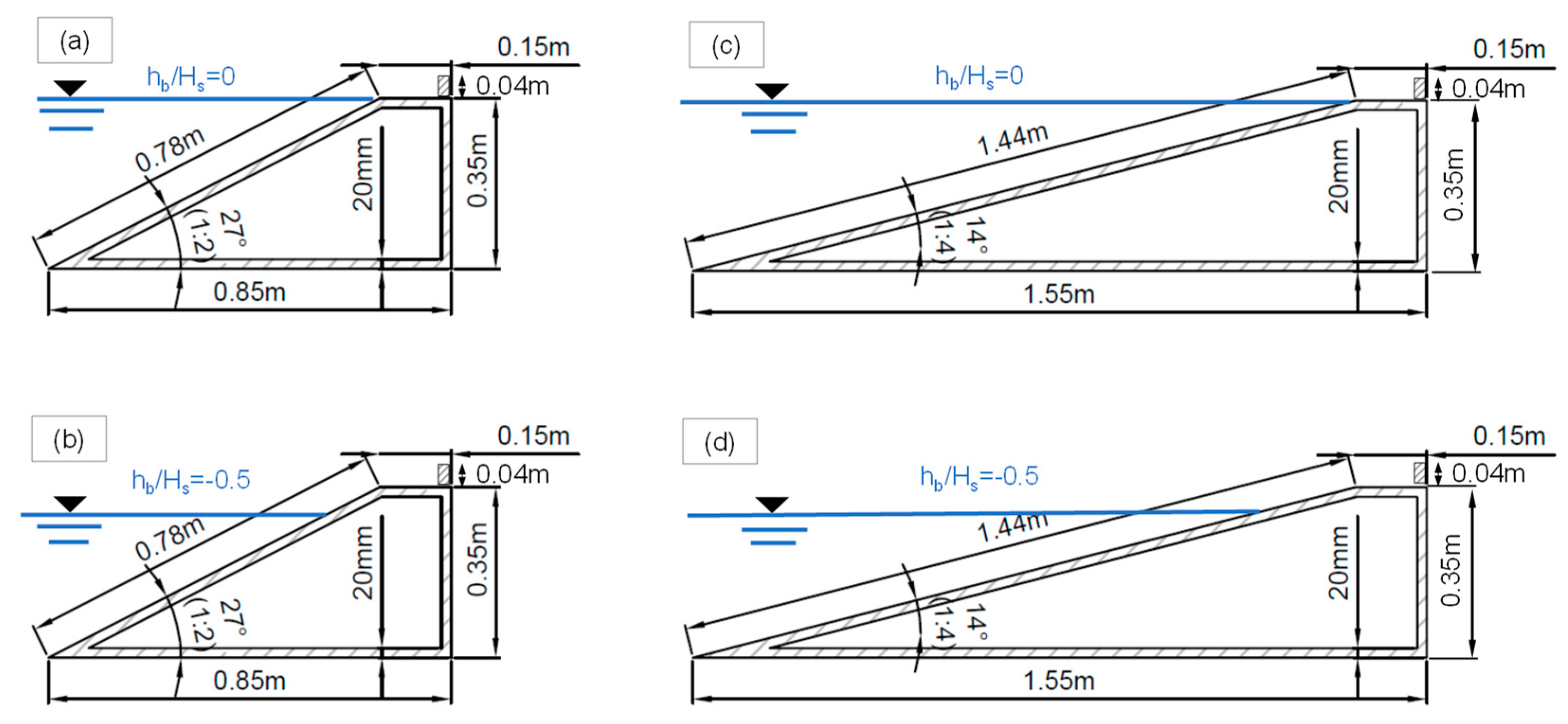
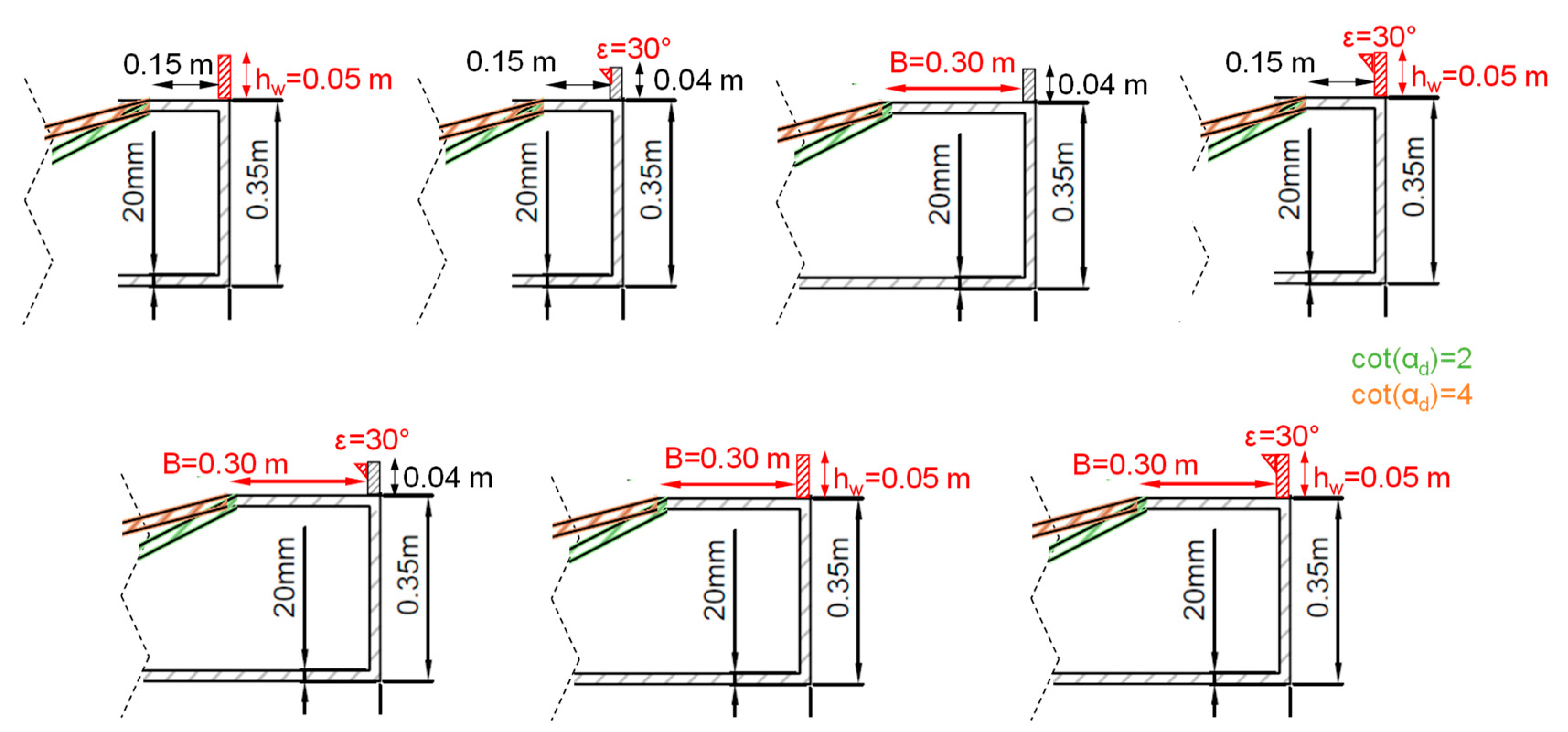

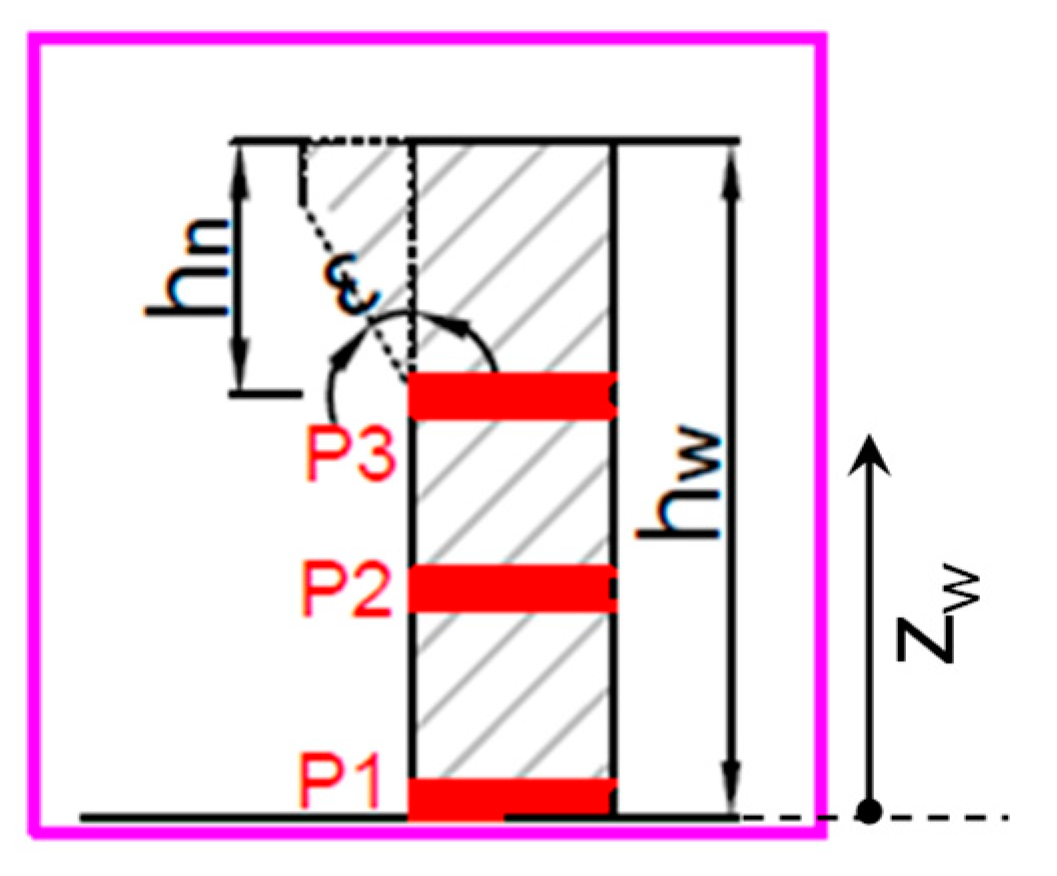
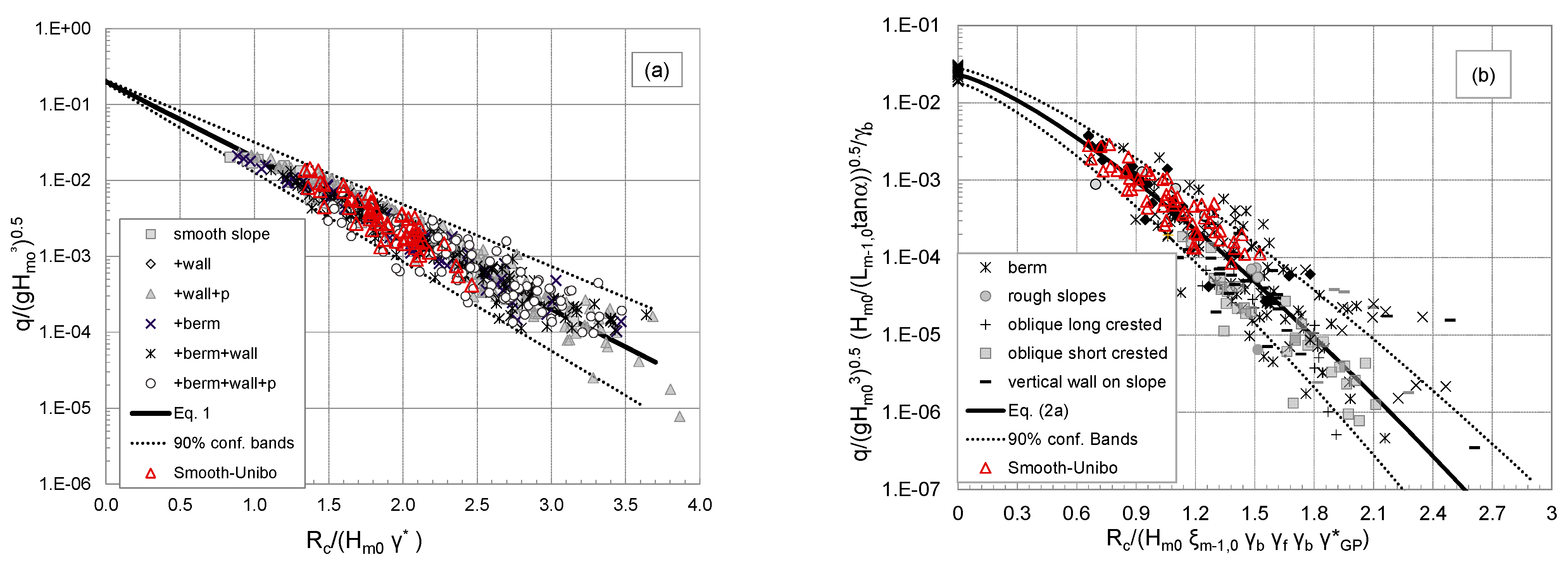
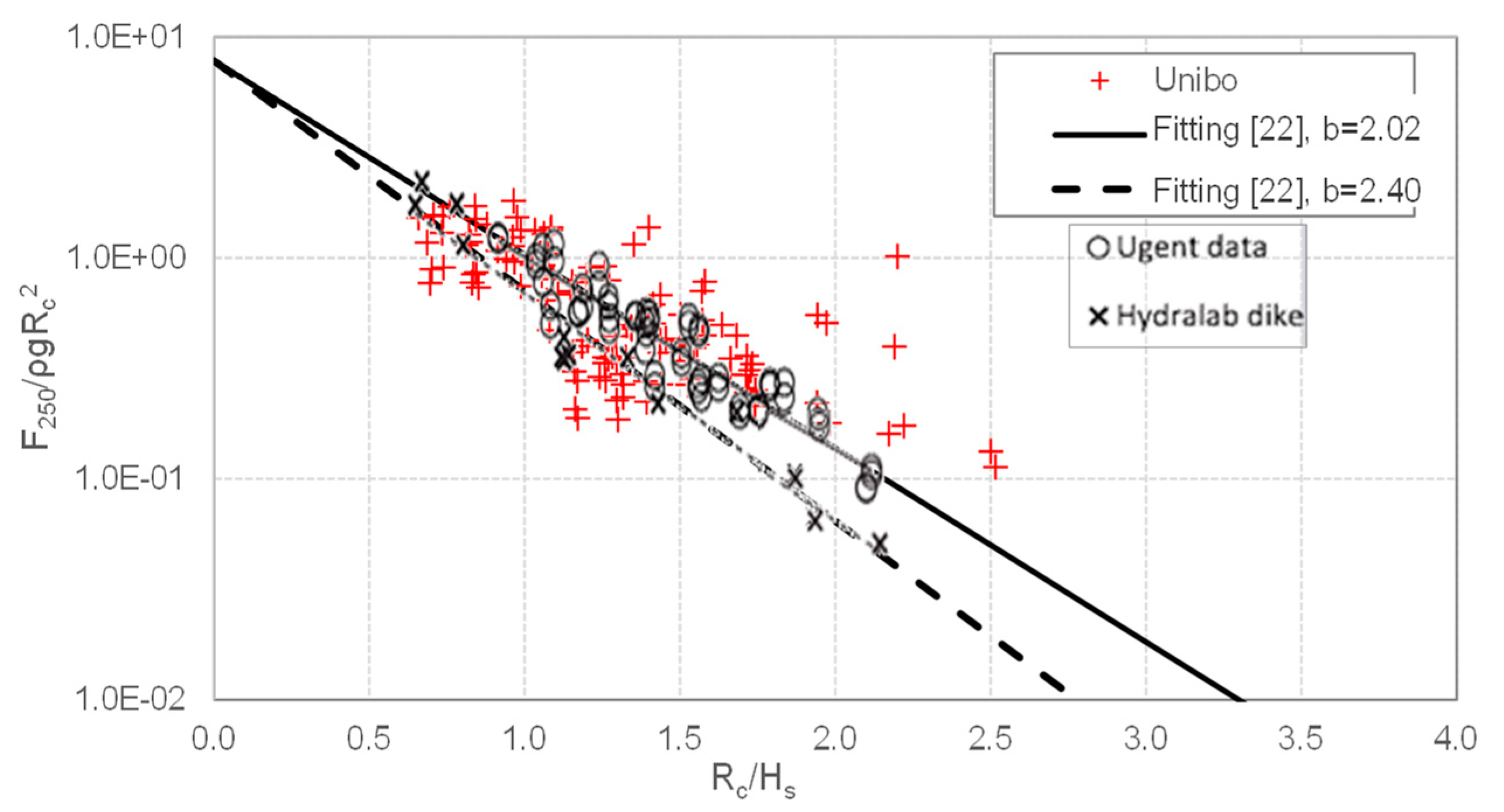
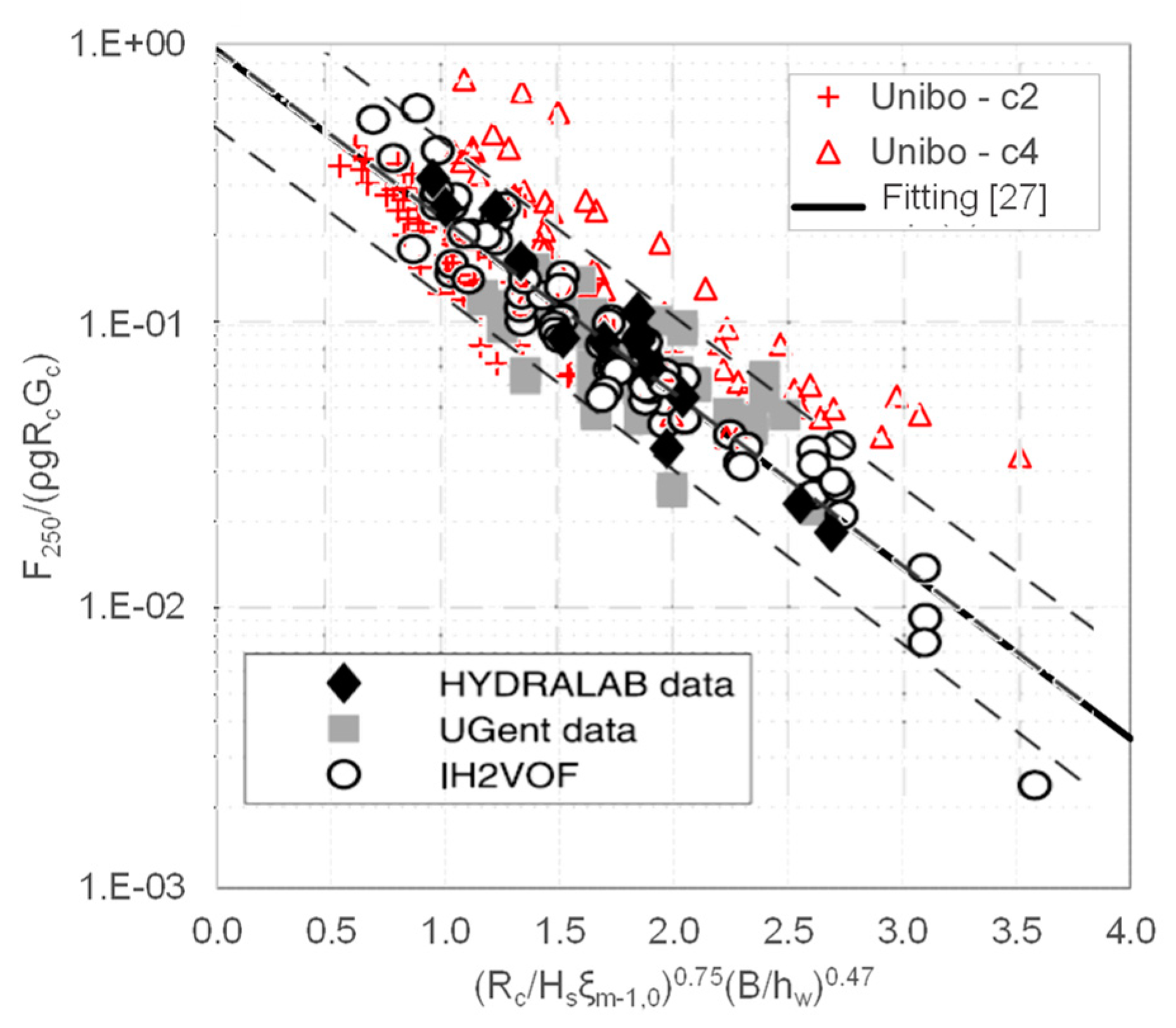
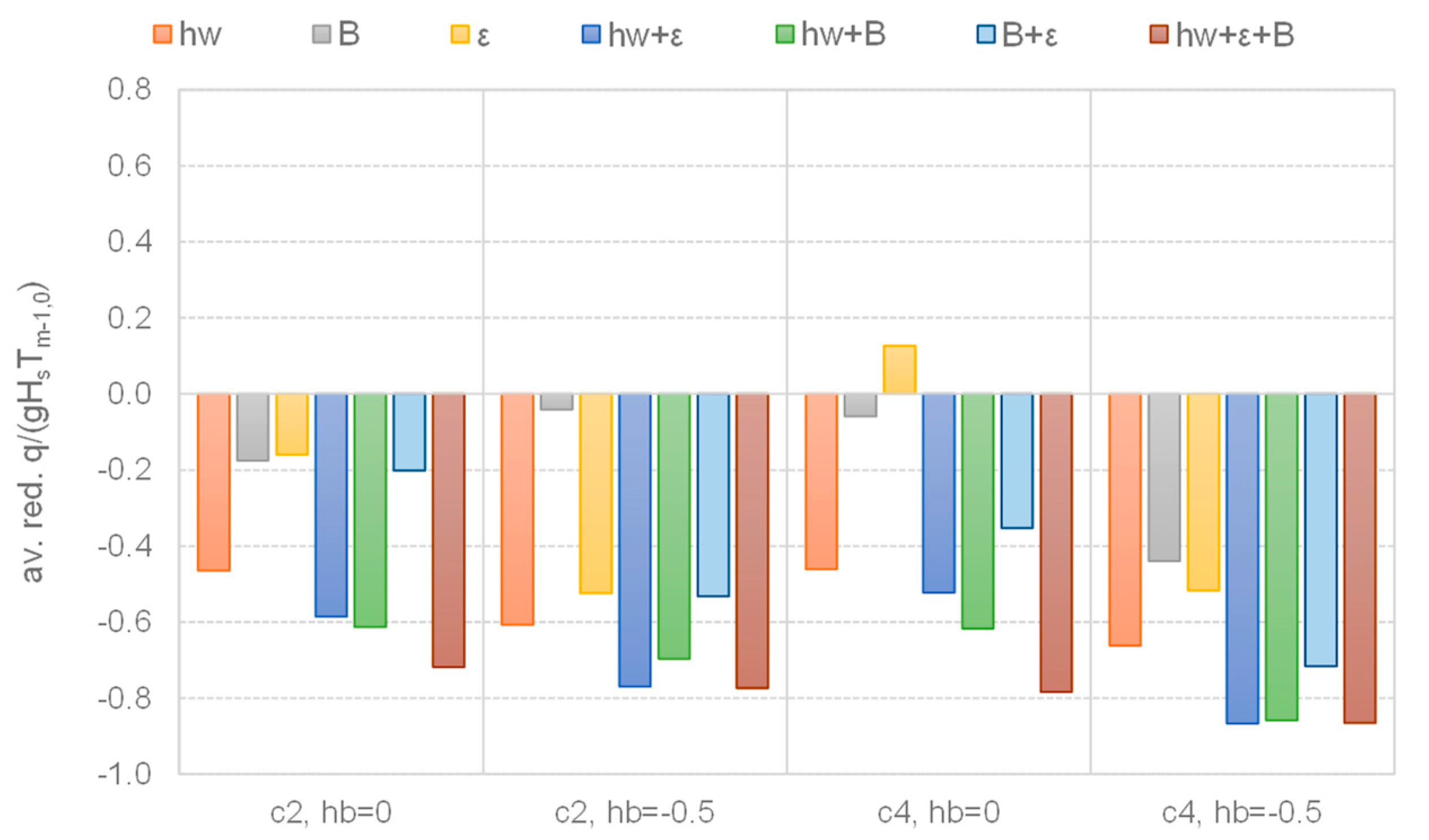
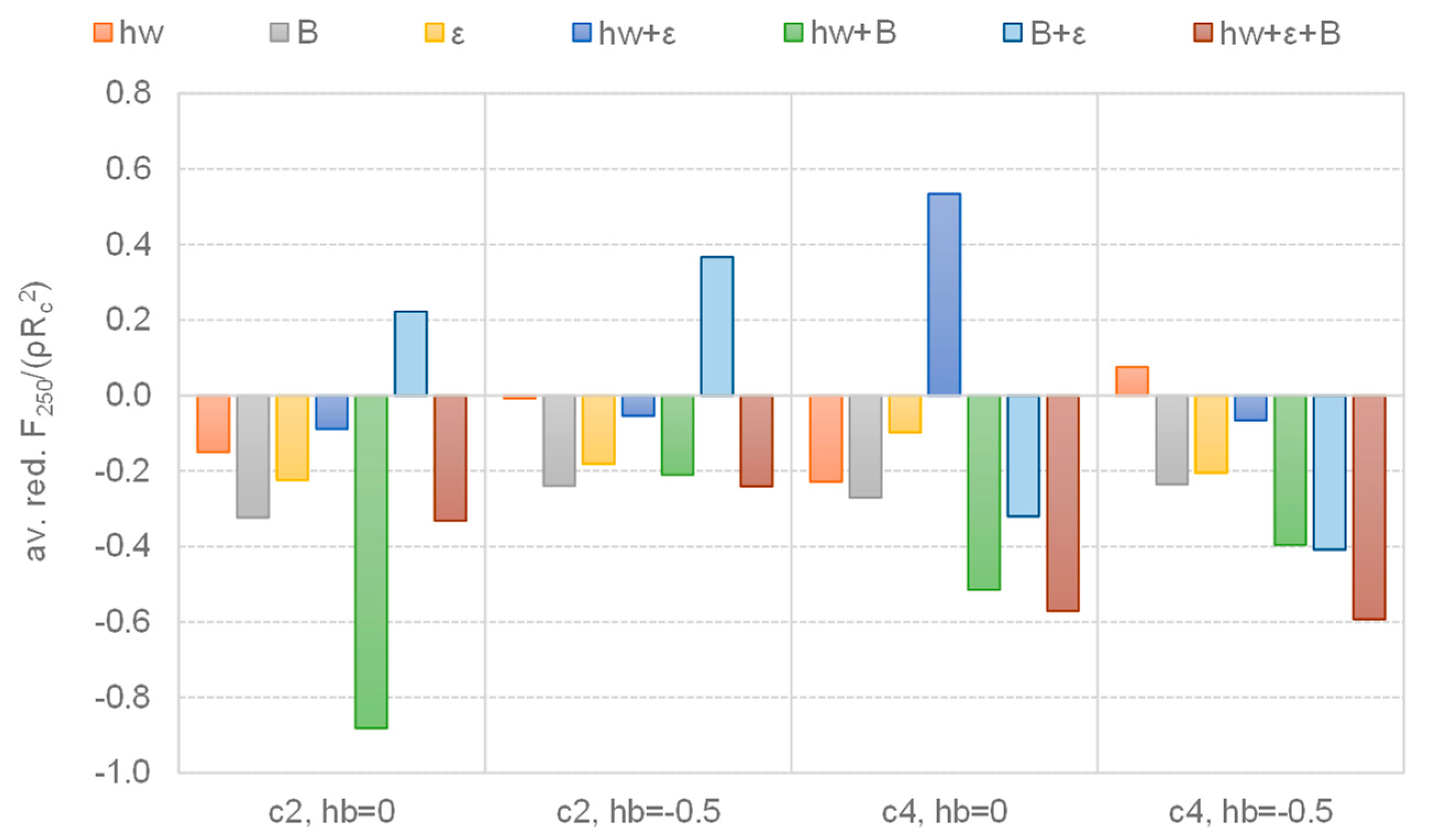
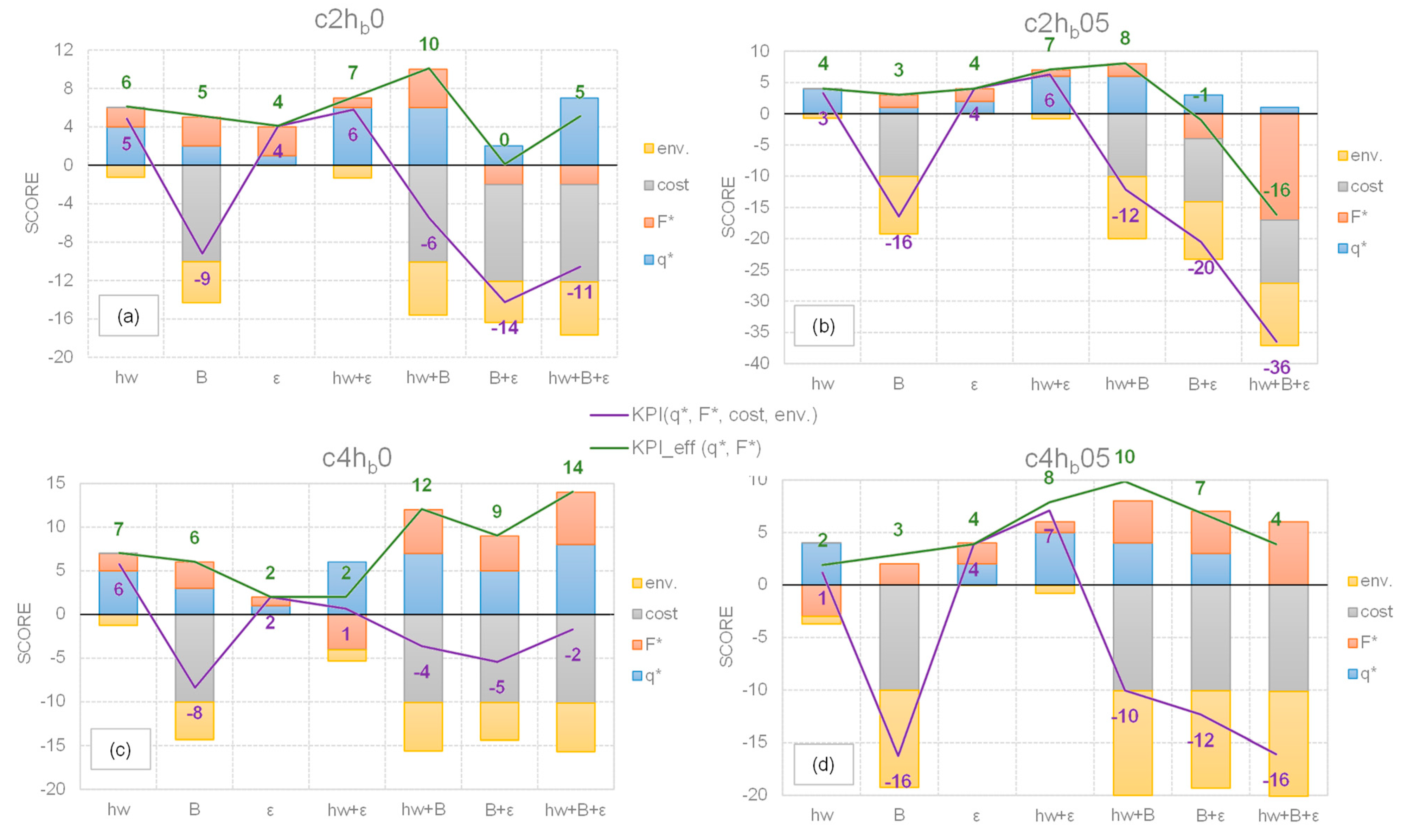

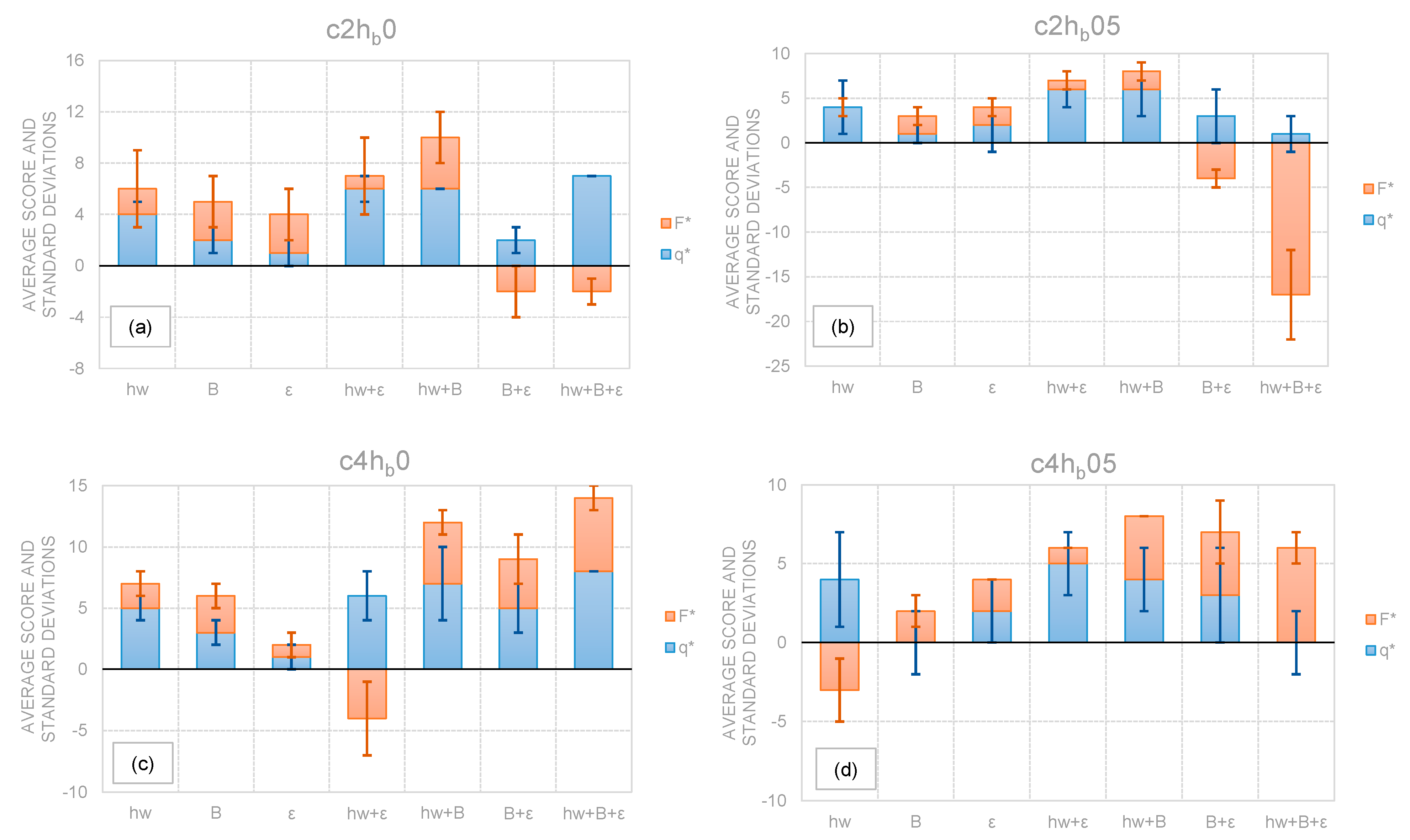
| Parameters | Configurations with hb/Hs = 0 | Configurations with: hb/Hs = 0.5 |
|---|---|---|
| Hs (m) | 0.05; 0.06 | 0.05; 0.06 |
| sm-1,0 (-) | 0.03; 0.04 | 0.03; 0.04 |
| cot(αd) (-) | 2; 4 | 2; 4 |
| B (-) | 0.15; 0.30 | 0.15; 0.30 |
| hw (-) | 0.04; 0.05 | 0.04; 0.05 |
| parapet (ε, λ) | no; yes (30°, 0.375) | no; yes (30°, 0.375) |
| # | 64 | 64 |
| Configuration | Test Wave Conditions | q* [-] | Red (q*) | F*250 | Red (F*) |
|---|---|---|---|---|---|
| Basic | Hs = 0.05 m, sm-1,0 = 0.03 | 3.34 × 10−4 | - | 1.56 | - |
| Basic | Hs = 0.05 m, sm-1,0 = 0.04 | 2.72 × 10−4 | - | 1.17 | - |
| Basic | Hs = 0.06 m, sm-1,0 = 0.03 | 7.32 × 10−4 | - | 1.01 | - |
| Basic | Hs = 0.06 m, sm-1,0 = 0.04 | 5.48 × 10−4 | - | 1.52 | - |
| Upgrade hw | Hs = 0.05 m, sm-1,0 = 0.03 | 1.79 × 10−4 | −0.46 | 0.81 | −0.48 |
| Upgrade hw | Hs = 0.05 m, sm-1,0 = 0.04 | 1.21 × 10−4 | −0.56 | 0.83 | −0.29 |
| Upgrade hw | Hs = 0.06 m, sm-1,0 = 0.03 | 4.84 × 10−4 | −0.34 | 1.24 | 0.23 |
| Upgrade hw | Hs = 0.06 m, sm-1,0 = 0.04 | 2.74 × 10−4 | −0.50 | 1.44 | −0.05 |
| μ | - | −0.46 | −0.15 | ||
| σ | - | 0.09 | 0.31 |
| Upgrade | ΔV (m3/m) | ΔV—Prototype (m3/m) | Δcost—Prototype (EUR/m) | ΔV/V (%) | Δenv. (-) |
|---|---|---|---|---|---|
| hw | 2.00 × 10−4 | 0.08 | 32 | 0.33% | 0.25 or 0.15 |
| B | 5.25 × 10−2 | 21.00 | 8400 | 86% | 0.87 or 1.87 |
| ε | 2.25 × 10−4 | 0.09 | 36 | 0.37% | 0.00 |
| hw + ε | 4.81 × 10−4 | 0.19 | 77 | 0.79% | 0.26 or 0.15 |
| hw + B | 5.27 × 10−2 | 21.08 | 8432 | 87% | 1.12 or 2.01 |
| B + ε | 5.27 × 10−2 | 21.08 | 8436 | 87% | 0.87 or 1.87 |
| hw + B + ε | 5.30 × 10−2 | 21.20 | 8477 | 88% | 1.13 or 2.02 |
| Min | 2.00 × 10−4 | 0.08 | 32 | 0.33% | 0 |
| Max | 5.30 × 10−2 | 21.20 | 8477 | 88% | 1.13 or 2.02 |
| Criterion | Scaling | Min Score | Max Score |
|---|---|---|---|
| I—Hydraulic effectiveness | Global | 0, associated with Red (q*) = 0 | 10, associated with Red (q*) = −1 |
| II—Structural effectiveness | Global | 0, associated with Red (F*) = 0 | 10, associated with Red (F*) = −1 |
| III—Costs | Local | −10, associated with Δcost = 8477 EUR/m | 0, associated with Δcost = 32 EUR/m |
| IV—Environmental impact | Local | −10, associated with Δenv = 2.02 | 0, associated with Δenv = 0 |
| KPI | KPIeff | Benefits/Costs | Configuration Effectiveness Based on Criteria I and II | Instruction |
|---|---|---|---|---|
| >0 | >0 | >1 | Effective | Recommended |
| >0 | =0 | >1 | Ineffective | Not recommended |
| >0 | <0 | >1 | Counterproductive | Not recommended |
| =0 | >0 | 1 | Effective | Recommended |
| =0 | =0 | 1 | Ineffective | Not recommended |
| =0 | <0 | 1 | Counterproductive | Not recommended |
| <0 | >0 | <1 | Effective | Neutral |
| <0 | =0 | <1 | Ineffective | Not recommended |
| <0 | <0 | <1 | Counterproductive | Not recommended |
| Ranking | Upgrade | μ(KPI) | KPI | KPIeff | Instruction |
|---|---|---|---|---|---|
| 1 | hw + ε | 5 | >0 | >0 | Recommended for all of the groups of structures |
| 2 | ε | 4 | >0 | >0 | Recommended for all of the groups of structures |
| 3 | hw | 3.75 | >0 | >0 | Recommended for all of the groups of structures |
| 4 | hw + B | -8 | <0 | >0 | Neutral for all of the groups of structures |
| 5 | B | −12.25 | <0 | >0 | Neutral for all of the groups of structures |
| 6 | B + ε | −12.75 | <0 | ≤0 for c2, >0 for c4 | Not recommended for c2; neutral for c4 |
| 7 | hw + B + ε | −16.25 | <0 | <0 for c2hb05 >0 otherwise | Not recommended for c2hb05; neutral otherwise |
| Config./Upgrade | Red (q*) | Red (F*) | Δcost (EUR/m2) | Δenv (-) | Score (q*) | Score (F*) | Score (Δcost) (-) | Score (Δenv) (-) | KPI(-) |
|---|---|---|---|---|---|---|---|---|---|
| (1) hw = 0.24 m | −0.68 | −0.04 | 86.40 | 0.38 | 7 | 0 | 0 | 0 | 7 |
| (2) hw = 0.33 m | −0.94 | −0.54 | 172.80 | 0.63 | 9 | 5 | 0 | −5 | 10 |
|
(3) hw = 0.24 m, B = 0.24 m | −0.85 | −0.35 | 723.40 | 0.68 | 9 | 4 | −3 | −5 | 3 |
|
(4) hw = 0.24 m, B = 0.3 m | −0.88 | −0.41 | 1360.40 | 0.83 | 9 | 4 | −7 | −8 | −2 |
|
(5) hw = 0.24 m, B = 0.36 m | −0.91 | −0.36 | 1997.40 | 0.94 | 9 | 4 | −10 | −10 | −7 |
| Config./Upgrade | Red(q*) | Red(F*) | Δcost (Eur/m2) | Δenv(-) | Score(q*) | EURScore(F*) | Score(Δcost) (-) | Score(Δenv) (-) | KPI(q*, F*, Δcost, Δenv) (-) |
|---|---|---|---|---|---|---|---|---|---|
| ε = 45° | 0.03 | 0.18 | 0 | 0 | 0 | −2 | 0 | 0 | −2 |
| ε = 60° | −0.28 | 0.77 | 0 | 0 | 3 | −8 | 0 | 0 | −5 |
| ε = 90° | −0.64 | 2.99 | 0 | 0 | 6 | −30 | 0 | 0 | −24 |
Publisher’s Note: MDPI stays neutral with regard to jurisdictional claims in published maps and institutional affiliations. |
© 2021 by the author. Licensee MDPI, Basel, Switzerland. This article is an open access article distributed under the terms and conditions of the Creative Commons Attribution (CC BY) license (https://creativecommons.org/licenses/by/4.0/).
Share and Cite
Formentin, S.M. Key Performance Indicators for the Upgrade of Existing Coastal Defense Structures. J. Mar. Sci. Eng. 2021, 9, 994. https://doi.org/10.3390/jmse9090994
Formentin SM. Key Performance Indicators for the Upgrade of Existing Coastal Defense Structures. Journal of Marine Science and Engineering. 2021; 9(9):994. https://doi.org/10.3390/jmse9090994
Chicago/Turabian StyleFormentin, Sara Mizar. 2021. "Key Performance Indicators for the Upgrade of Existing Coastal Defense Structures" Journal of Marine Science and Engineering 9, no. 9: 994. https://doi.org/10.3390/jmse9090994
APA StyleFormentin, S. M. (2021). Key Performance Indicators for the Upgrade of Existing Coastal Defense Structures. Journal of Marine Science and Engineering, 9(9), 994. https://doi.org/10.3390/jmse9090994





